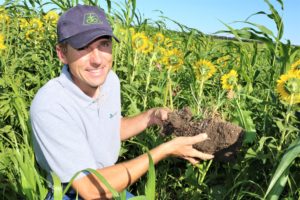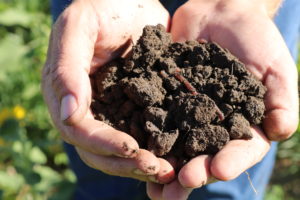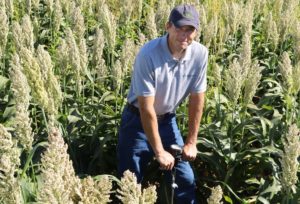
Justin Knopf, of Knopf Farms, is a is a fifth-generation farmer in Kansas.
By Heather Emmons, USDA
Justin Knopf, of Knopf Farms near Gypsum, Kansas, is a fifth-generation farmer and a partner in a diversified operation that grows wheat, alfalfa, corn, soybeans, and sorghum.
Resiliency on the Rise
Justin started farming with his father in the 1990s. Having learned the ropes, he started farming full time in 2003. If there’s one word he thinks about the most—from a business, environmental, agronomic, and human resource standpoint—it’s resiliency.
Building a relationship with USDA has been key to the operation’s resiliency. Working with USDA’s Farm Service Agency, Risk Management Agency, and Natural Resources Conservation Service helps Justin to manage risk and his land.
“One of the resources we think about regularly on our farm is human resources – and collaboration with other people. The collaboration we have with RMA, FSA and NRCS is important to our team,” said Justin. “These agencies’ programs help us offset risks we face season-to-season as we deal with weather and markets out of our control.”
Justin protects his eligible commodities with crop insurance, administered by RMA. He also covers his alfalfa with FSA’s Noninsured Crop Disaster Assistance Program, which provides financial assistance to producers of noninsurable crops when low yields, loss of inventory, or prevented planting occur due to natural disasters.
Additionally, he enrolled in the Agriculture Risk Coverage and Price Loss Coverage program to prepare for potential market downturns and provide a crucial safety-net for his operation.

USDA programs help Jason protect and conserve resources on his farm.
Investing in the Land
NRCS programs have given Justin the assistance to invest and implement solutions that conserve natural resources for the future while also improving his operation.
This year, Justin is embarking on a major multi-year Environmental Quality Incentives Program project, cleaning up a pasture that he’s taken ownership of recently and getting all the invasive tree species out.
“Currently, we have no livestock on the farm. As we’re looking at the direction, we’re moving with our soil health and building resiliency, and if we’re able to integrate livestock and grazing into that system, it will improve our soils at a more rapid rate,” said Justin
Not only has financial assistance been helpful, but equally valuable to Justin is having technical expertise from the NRCS regional range expert.
“Most of my expertise is focused on croplands, not in range,” he said. “Having access to that technical information to help me start on my learning curve in dealing with range and native plants has been important in starting to undertake the process of introducing livestock and grazing.”
Justin has also enrolled some of his land in the Conservation Reserve Program to reduce soil erosion, supply nutrition for pollinators, and rehabilitate habitat on his land.
“Justin has a passion for agriculture,” said Amanda Ahrens, county executive director for FSA in Saline County. “He enjoys telling his story to help others and provide a stronger foundation for the next generation.”

Justin has been doing on-farm research trials for a decade.
Research and Regeneration
Justin just completed his Conservation Stewardship Program contract, which helps to improve existing conservation systems and address resource concerns. Practicing no-till farming for a long time, he wanted to take the next step in regenerative agriculture.
“It became clear to me that implementing multi-species cover crops across the majority of our acres is important,” he said. “Planting cover crops in our open periods between the regular crops is key. Taking the risk in a long-term investment such as cover crops is a different way of managing things and a different mindset.”
Justin has been doing on-farm research trials for a decade, and he’s still refining what he’s doing and on a steep learning curve, each year expanding the number of cover crop acres planted.
“As our soils are changing and our knowledge base continues to change, the right answers today may not be the right answers next year and the year after that,” he said. “Continuing to learn, observe and adapt in the name of resilience and regeneration is the bottom line. It’s an important conversation we all need to be having… What are we doing to get better and improve what we’re doing in relation to our natural resources, and how are we going to take that next step forward?”
More Information
USDA offers a variety of risk management, disaster assistance, loan, and conservation programs to help agricultural producers in the United States weather ups and downs in the market and recover from natural disasters as well as invest in improvements to their operations. Learn about additional programs.
For more information about USDA programs and services, contact your local USDA service center.
For a digital version of this blog, visit #FridaysOnTheFarm.





